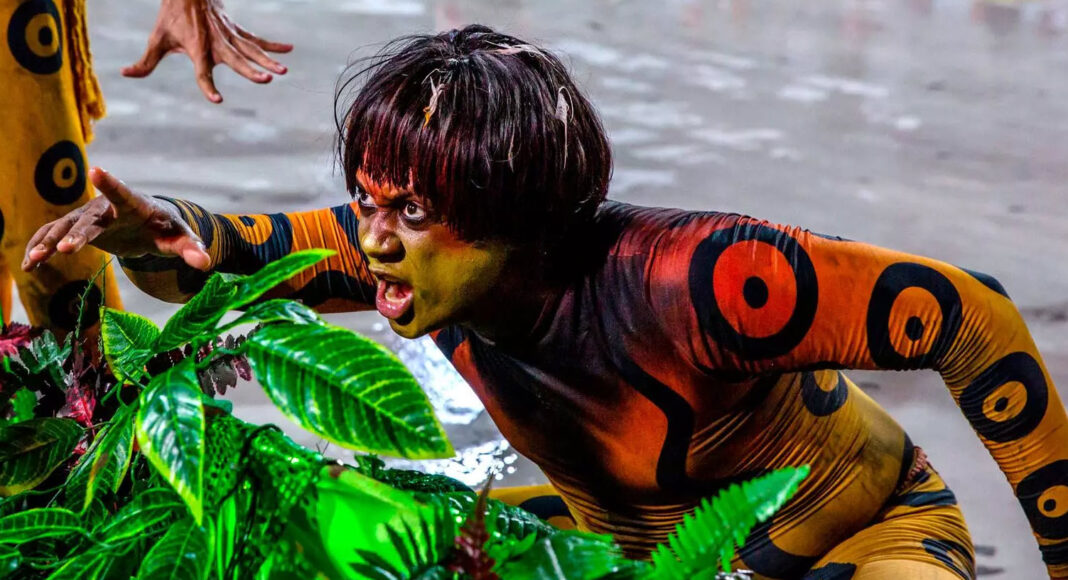This article is reproduced by kind permission of Sumaúma. You can see the original here. It complements an earlier Sumauma article LAB republished on 12 January.
Sumaúma, journalism from the centre of the world, is based in Altamira, Pará, in the Brazilian Amazon. It was established one year ago by Eliane Brum, Jonathan Watts, Verônica Goyzueta, Talita Bedinelli and Carla Jiménez.
Main image: Strength of the forest: participant at Salgueiro’s rehearsal represents a xapiri, a being that helps Yanomami shamans protect the earth. Photo: Ana Carolina Fernandes/Sumaúma
In developing its carnival theme, the Salgueiro samba school drew on the knowledge of Yanomami shaman Davi Kopenawa, whose visit to the Rio de Janeiro community forged a bridge between favela and forest, reviving the transgressive power of Brazil’s most popular festival.
It wasn’t the first time Davi Kopenawa, leader, shaman, and ambassador of the Yanomami people in their struggle for their “land-forest,” had been to Rio de Janeiro. But on his earlier trips there to attend exhibits, lectures, or tributes, it had never crossed his hosts’ minds to invite him to a favela. Built mainly on the city’s steep hillsides, these urban communities were originally settled by once enslaved Black people and then by waves of migrants, primarily from Brazil’s Northeast. Favela residents have no access to housing “down on the asphalt”—a slang term for the wealthier areas of Rio, where most tourists spend their time. So when he visited Morro do Salgueiro—the birthplace of Acadêmicos do Salgueiro, the Rio de Janeiro samba school that will pay homage to the Yanomami people in this year’s Carnival parade—it was a revelation for Davi.
Marcos Wesley, an Indigenous specialist at the Socioenvironmental Institute who has worked with the Yanomami people for 27 years, accompanied Davi on the visit in mid-October 2023. According to Marcos, “[Davi] said they had taken him to tourist sites in Rio a few times, but this was the first time he had met the people who built the city of Rio de Janeiro.” Anyone who has had the chance to roam the cities of the world with Davi knows the Yanomami leader always has insightful and very surprising observations, grounded in another way of experiencing life. When Davi stepped into a favela for the first time, he said: “They built it, right? And then they were pushed over here, where there’s nothing but rock, nowhere to plant. It’s a lot of injustice.” In a TV Globo news report at the time, the shaman said: “I’m really very moved, because I’ve never seen anyone who lives in a place like this, on top of rock. To me, in my Yanomami culture, this rock doesn’t protect.”
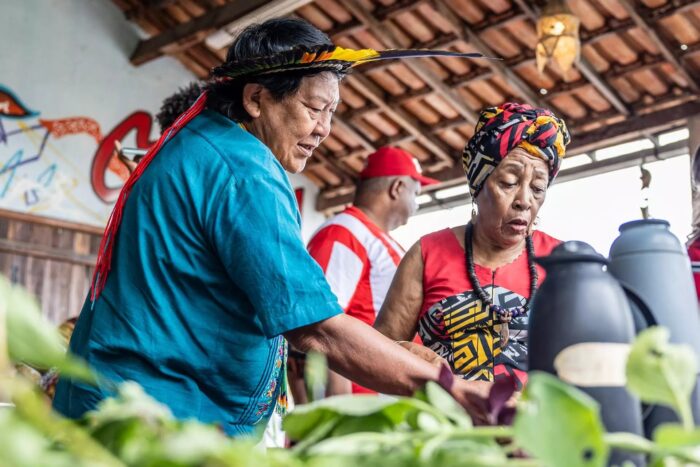
Up on Salgueiro hill, Davi Kopenawa was received at Caxambu, a cultural center that preserves the community’s Afro-Brazilian traditions, most notably the jongo, a dance performed to the sound of drums. Among those at the cultural center were the matriarchs of the Salgueiro school, including Maria da Glória Lopes de Carvalho, better known as Tia Glorinha—Aunt Glorinha—77 years old and for the last 15 years president of the Alas das Baianas, or Baianas Wing, where Tia Glorinha has danced since 1963. In this traditional section of the parade, older women whirl down the avenue in enormous hoop skirts. She and Davi chatted about medicinal herbs, since Tia Glorinha’s mother, who moved to Morro do Salgueiro from the nearby state of Minas Gerais, passed her knowledge as a rezadeira, or healer, down to her daughter. “He wanted to know what each herb was called here and whether they matched the herbs up there, which have different names,” says Tia Glorinha. “He was delighted, and I was too. I never imagined he would come to my community.” Davi told his traveling companion Marcos Wesley that the women at the Caxambu cultural center reminded him of his own aunts.
The mood was a little tentative at the outset of this encounter in the hillside community, but it ended in a creative exchange between the shaman who lives in the collective house of Watoriki, at the foot of the Serra do Vento mountains on the border of Amazonas and Roraima states, and the leaders of one of Rio’s most traditional samba schools. The initial contact was made in March 2023, shortly after Salgueiro announced its central theme, “Hutukara,” which is what Yanomami shamans call the sky that fell in ancestral times, forming today’s Earth. Hutukara is also the name of the best-known association in Yanomami Indigenous Land, headed by Davi himself.
Davi had only two requests of the samba school: first, that Salgueiro not portray a generic Indigenous person but rather the Yanomami, with their unique traits, body paint, customs, and worldview, and second, that the Yanomami not be depicted as sufferers but instead as a resilient people who possess great knowledge and wisdom. “He said: ‘We’re going to fight all the time,’” recalls the journalist Igor Ricardo. Igor is Salgueiro’s enredista, the person who writes the synopsis that serves as a reference in developing the school’s theme through song and presentation. His role is also to compose the official text submitted to the jury that judges the parade—a dazzling performance held annually in the narrow, half-mile-long Sambadrome arena or, as those from Rio de Janeiro often say, “on the avenue.”
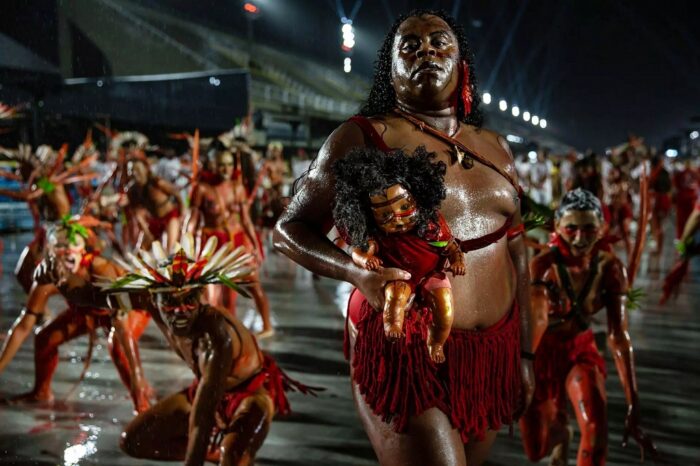
Igor met Davi Kopenawa for the first time at the São Paulo offices of the Moreira Salles Institute in early April 2023. Also in attendance that day was Edson Pereira, Salgueiro’s carnavalesco, or Carnival director, who is in charge of costume and float design. The two men wanted to obtain Davi’s blessing for their central theme and invite him to the parade on the night of February 11, 2024. The meeting got off to a tense start. Someone from the Salgueiro team was wearing jewelry made of solid gold, symbol of the illegal mining operations that are devastating Yanomami lands and bringing genocide to Davi’s people, killing 308 from January through November 2023 alone—more than half of them children under the age of five and most for preventable causes.
Davi’s face clouded over when he saw the man’s neck, arms, and fingers aglitter with gold. Igor, the school’s theme writer, says the Yanomami leader greeted no one but directed himself immediately to the person draped in gold: “You know this is death for me, right?” Only gradually did the conversation loosen up. Igor told Davi he was reading the book The Falling Sky, the product of 93 hours of recorded conversations between the shaman and the anthropologist Bruce Albert—and likewise the result of their close friendship and years of interaction. Davi told Igor this was “a good start.”
The Yanomami people place great value on friendship, whether with other human people or with the forest and its beings. But they don’t forget how the napëpë—non-Indigenous, white people—have often pretended to befriend them. In The Falling Sky, Davi Kopenawa says he wants his words to penetrate the minds of new generations of napëpë so they will “feel much greater friendship for the forest.” In the course of this three-hour-plus conversation in São Paulo with members of the Salgueiro samba school, Davi, as usual, didn’t beat around the bush: “You want to be our friends, is that it?” Only at the end did the shaman say, “Now you can come to my house.”
The suggested trip to Demini, the region where Davi lives in Yanomami Indigenous Territory, has not yet taken place. But Davi entrusted the Indigenous specialist Marcos Wesley with the tasks of providing Igor and Edson with material on the Yanomami and serving as his intermediary in responding to their many questions. “This meeting with Davi prompted a big shift in our thinking,” admits Igor.
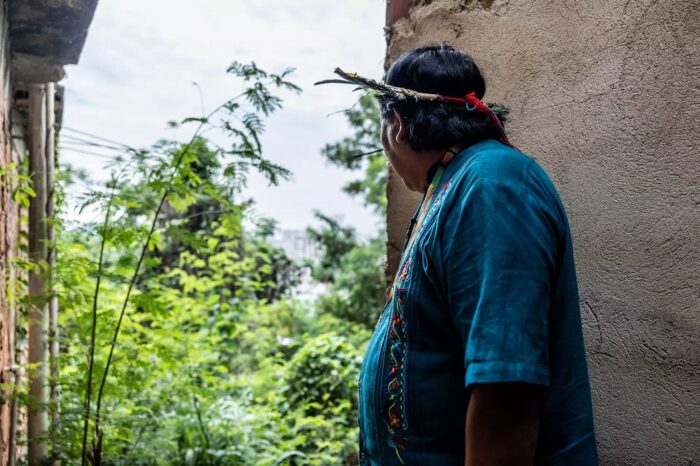
Resistance, folklore, and gambling
Rio de Janeiro’s first samba school parade took place in 1932, but themes centering on the Indigenous only became more common from 1970 on, according to the historian Luiz Antonio Simas, author of several books on Carnival, Rio de Janeiro, and Afro-Brazilian religions. That year, Portela won with the theme “Legends and Mysteries of the Amazon.” Like most subsequent parades about Brazil’s original peoples, the topic explored Indigenous myths without linking them to these peoples’ struggles to maintain their lands and secure political space. “Many themes were based on the folkloric logic of a literature of Brazil that romanticized the Indigenous as ‘good savages,’ in myths about nation-building,” says Mauro Cordeiro, a Carnival scholar who was born in Morro do Andaraí, near Salgueiro hill, and has been a member of the school since childhood, when his father was the club’s director.
Mauro, a professor and PhD candidate in anthropology, recalls that it was a Black Carnival director, Fernando Pinto (1945-1987), who first showcased the demands of Brazil’s Indigenous peoples in a parade by one of Rio’s top-tier schools. In 1983, before the 1988 Constitution enshrined the rights Congress now wants to overturn, Fernando Pinto created the theme “How Green Was My Xingu” for the school Mocidade Independente de Padre Miguel. In 2017, when the far-right was gaining ground, Raoni Metuktire, the most eminent representative of the Indigenous struggle in Brazil, took part in the parade by Imperatriz Leopoldinense, whose theme was “Xingu, A Cry from the Jungle.”
At the time, agrobusiness associations saw themselves in the “beautiful monster” who “steals their children’s land”—a line from Imperatriz Leopoldinense’s theme song—and they protested. But the school wasn’t focusing so much on the land grabbing that is laying waste to the Amazon, or on the conversion of the rainforest to pastureland for grazing cattle or raising soy, or on illegal logging, but rather on a destructive hydroelectric power plant built near the city of Altamira when the Workers’ Party was in power. Officially called Belo Monte—Beautiful Mountain—the hydroplant has become known in the region as Belo Monstro—Beautiful Monster.
In 1998, with “Parintins, the Island of Boi-bumbá,” Salgueiro touched on the Indigenous world, but this topic has never been its trademark. Founded in 1953 on a hill settled by Black Brazilians formerly enslaved on coffee plantations, the school was among the first to showcase Black history and heroes in their parade. Zumbi dos Palmares, the leader of enslaved Africans who rebelled; Chica da Silva, a freed woman who grew to a position of great wealth; and Aleijadinho, a Baroque sculptor born to a Portuguese father and one of his enslaved women, were all the subjects of parades as early as the 1960s. “Salgueiro has probably presented Black themes in Carnival more times than any other school, so I wouldn’t say that an engagé Carnival is anything new for them. What’s really new is that this is about the Indigenous issue,” says Professor Mauro Cordeiro.
The historian Luiz Antonio Simas points out that samba schools are chameleon-like—one year they take up a theme about resistance while the next year they stick to the status quo. Even so, he argues, there is always an underlying engagement, whatever their theme. “I start with the assumption that a samba school is always engagé. You have a community structure that is part of Afro-Rio sociability; you have the sound of the percussion, which dialogues with Candomblé and Umbanda terreiros [Afro-Brazilian religious sanctums]. So it’s a manifestation of non-white cultures even when it apparently isn’t,” says Simas.
This characteristic has held true even though some of Rio’s major schools have close ties with the city’s illegal gambling business, which started out with a traditional lottery game where gamblers bet on animal names and now extends to clandestine bingo, slot machines, and casinos. For over thirty years, until the late 2010s, the Salgueiro samba school itself was under the direct or indirect command and patronage of the so-called Garcia clan, a family of gambling bosses who were the target of murder attempts and were accused of involvement in violent crimes. This meant the school had lots of money—and many championships “on the avenue.” To this day, rumor has it that family heirs are attempting to regain control of the school through allies. This doesn’t stop Salgueiro members from boasting their school is “authentic,” meaning it has deep roots in its community. In 2024, only two of the school’s 26 wings allowed non-members to buy costumes and dance in the parade.
The contradictions of Rio’s Carnival are evident. Likewise evident is the potential impact of a parade by a first-division school, a category that comprises the best-placed schools from the previous year—a ranking Salgueiro has always enjoyed. Broadcast to millions of people, a school’s parade can send a message if the theme captures the spirit of the times and its song is powerful. With this homage to the Yanomami, Salgueiro’s theme and song are already being heralded as one of the best, if not the best, this year. “It’s the type of theme song where you say the samba won’t be left forgotten on the avenue,” says Simas.
Professor Mauro Cordeiro hopes for a “spectacular parade” that plays the role of “raising awareness about the reality of the Yanomami people and the need to recognize their rights and dignity.” This is also the intention of Davi Kopenawa, who will ride on the last float, along with other leaders and artists of the Yanomami and Ye’kwana peoples (a second ethnic group that lives in the same Indigenous territory) and guests from other original peoples. Davi will also bring two shamans, who will summon to the avenue xapiri, the beings who help shamans care for the forest. “It’s not just a celebration, it’s not just a tribute, it’s a way of touching people’s hearts and minds,” explains Marcos Wesley.
Hornets and the Black struggle
When he was in Rio de Janeiro last October, Davi Kopenawa got to know the whole Salgueiro circuit. In addition to visiting the community perched on the hills, he toured the school’s nearby rehearsal grounds and the large facility in the portside neighborhood of Gamboa where work on its six floats was underway. A statue of Omama, creator of the Yanomami, will be featured on a float near the front of the parade. When Davi saw a drawing of it, he frowned. He didn’t say anything at the time but later asked Marcos Wesley to deliver the message that Omama had to be the “most perfect Yanomami,” with very short hair and proper body paint.
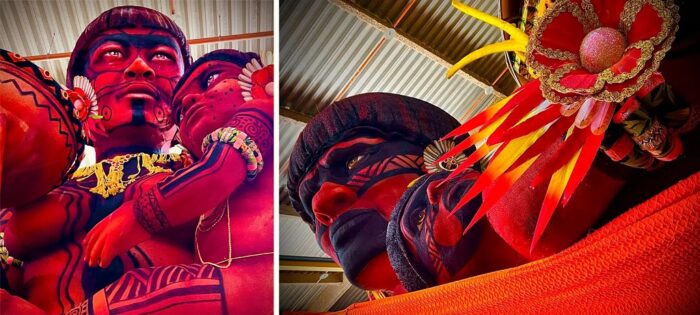
During this pilgrimage, Davi asked if the school had any children in it, because he felt they would pay more attention to him than adults and then tell their parents what they had discovered. So he was offered the opportunity to talk to some “Salgueiro Apprentices,” the girls and boys who will form the school’s next generations of percussionists and dancers. This Carnival, children will samba down the avenue in their own wing for the first time in 16 years. The “apprentices” asked the shaman a lot of questions, including the meaning of his name, Kopenawa. Davi told them that after he was married, he received the name from the xapiripë of hornets, which the Yanomami call kopena, who had drunk the blood of Arowë, a brave warrior from the past. He was given the name Davi by the napëpë (non-Indigenous, or whites) when he was a boy. “The children asked if they could hug him, and I saw Davi laugh for the first time,” says theme writer Igor Ricardo.
The Yanomami leader was also present at the rehearsal grounds when the school chose its song. The day before, he had met with the composers of the three finalist sambas. Marcelo Motta, who has been a member of the Composers Wing for 24 of his 41 years and is one of the authors of the winning samba, recalls that Davi began by speaking in his own language before switching to Portuguese. “This hit us really strong. Even though we couldn’t understand him, he was able to convey [his message] through emotion. He is a noble energy in his own right,” he says.
As the co-author of nine sambas selected to represent the school over the years, Motta says he has received videos from all over Brazil with people singing this year’s song, which “broke out of the Carnival bubble.” The verses “I learned Portuguese, the language of my oppressor, so you will know that my torment is also your lament,” are a reference to Davi. “He made a point of stressing that it is a mission to be here, that the Yanomami people need to be heard,” Motta says. According to Igor Ricardo, Davi once again talked about the houses built on top of rock during his conversation with the composers. “The big message he left us with was that our struggles, Blacks—he used that word—are now his struggles too,” Igor says.
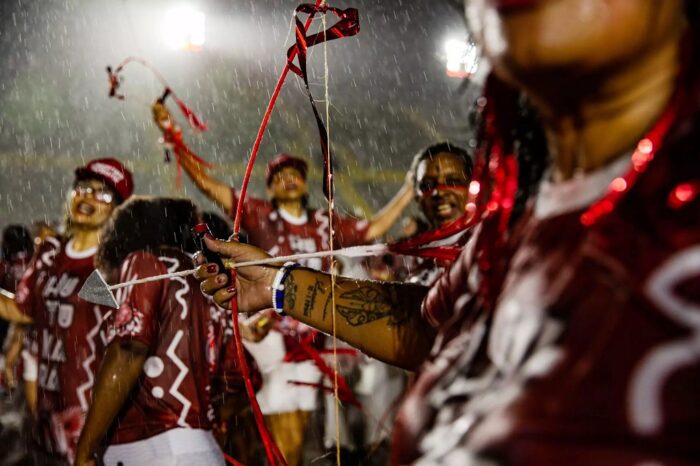
Professor Mauro Cordeiro feels this is a “happy, joyful” moment for Salgueiro, because the school hopes to serve as “an arrow that touches the hearts of all non-Indigenous people” when it comes to the Yanomami cause. Hopes are also high that the school will win its “tenth star,” says Tia Glorinha, Baianas Wing president. Salgueiro was champion for the ninth and last time 15 years ago, in 2009.
On January 21, the school held a technical rehearsal at the Sambadrome. The lights along the parade route were turned off to let the fluorescent bracelets worn by participants glow, as if they were xapiri dancing down the avenue. In the pouring rain, the crowds packing the stands rushed into the street to samba behind the school. Some people were holding photographs of the journalist Dom Phillips and the Indigenous specialist Bruno Pereira, murdered in 2022 in Javari Valley Indigenous Territory, in the state of Amazonas. Some sported caps from the Landless Workers Movement. Others had placed flowers behind their ears, like Yanomami women do. Still others were wearing T-shirts from Mangueira, Salgueiro’s “godmother” school. And everyone knew the song by heart.
What will happen during the parade itself “is always an enigma,” as the historian Luiz Antonio Simas says. But in addition to its usual Afro-Brazilian saints and orixás, this time the Salgueiro community can count on help from the forces of the forest to bring the crowd lining the avenue to its feet.
Read more: Understanding the Yanomami in Salgueiro’s samba school parade


